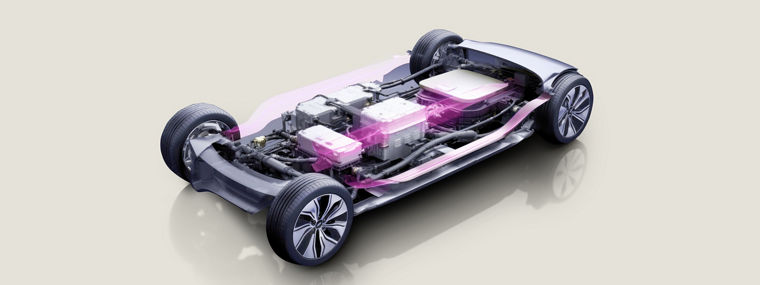Improving adhesion of polyurethane potting systems: New ORTEGOL® AP 100 adhesion promoter for 2K PU systems
Benefits at a Glance
- ORTEGOL® AP 100 is an adhesion promoter ideally suited for use in 2K PU systems
- Provides excellent adhesion to metal and plastic surfaces
- Works well in both, foamed and compact PU systems
- Ideally suited for use in EV battery potting applications
Potting System for Cylindrical EV-Batteries
Typically, they can be broken down into several design levels. The smallest unit is the battery cell where the electrochemical reaction takes place. In state-of-the-art batteries these cells can either have a cylindrical, prismatic or pouch-type geometry. Individual cells are organized into modules, which are subsequently assembled into a battery pack. This hierarchical structure is schematically illustrated in Figure 1.

Figure 1: Schematical design of a state-of-the-art EV battery.
To assemble cylindrical battery cells into modules and packs, it is standard practice to fill the gaps between the cells with a potting system. This system not only fixes the entire assembly but also provides essential mechanical stabilization to the cells. The technical requirements for such potting materials typically include:
Due to their advantageous balance of performance and cost, rigid or semi-rigid polyurethane (PU) foam systems have emerged as ideal solutions for these applications. Typically, PU potting materials are applied as pour-in-place formulations. This process involves filling the cell assembly with a reactive, water-blown polyol-isocyanate mixture. Upon reaction, the PU system expands to fill the cavities between the battery cells. To prevent damage to the battery cells during this process, it is crucial to minimize the heat generated by the reaction. The target density for the cured PU potting is generally between 300 and 400 kg/m³.
Adhesion Promoters for PU-Potting Systems
One significant drawback of conventional potting systems is their often insufficient adhesion to the surfaces of the battery cells, which can adversely affect the stability and longevity of the battery pack. Our innovative adhesion promoter, ORTEGOL® AP 100, is specifically designed to address this technical challenge. When incorporated into PU potting systems, ORTEGOL® AP 100 can enhance the adhesion of PU foams on both, metal and plastic surfaces, by at least 30 to 40%. By this is supports the mechanical robustness of the battery assembly which helps to ensure that EV batteries operate reliably and efficiently over their lifecycle.

Figure 2: Adhesion force of a PU potting system without (left) and with ORTEGOL® AP 100.
When used in PU foam pottings, ORTEGOL® AP 100 can be formulated into the polyol component or dosed as a separate component prior to application. In formulated systems, ORTEGOL® AP 100 is long-term stable and does not adversely affect the shelf life of the formulation. Notably, substantial improvements in performance can be observed at low usage levels, typically in the range of 1 to 3 weight percent (with respect to the overall PU formulation). It is important to note that ORTEGOL® AP 100 may have a slight delaying effect on the reactivity of the PU system; therefore, readjustment of the catalyst may be necessary. However, taking this into account, ORTEGOL® AP 100 will not have any major adverse impacts on the properties of both the PU formulation and the cured potting foam.
In addition to its application in PU foam pottings, ORTEGOL® AP 100 is also well-suited as an adhesion promoter in other types of PU applications, such as compact PU adhesives used in laminated rigid PU panels. Its versatility makes it an invaluable addition to various polyurethane formulations, enhancing adhesion and overall performance.
